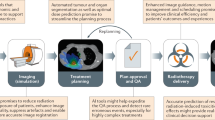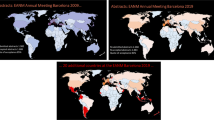Abstract
The aim is to support the perception of artificial intelligence in the radiation therapy landscape.
Similar content being viewed by others
Explore related subjects
Find the latest articles, discoveries, and news in related topics.Avoid common mistakes on your manuscript.
Artificial intelligence (AI) is becoming part of medical daily clinical practice and is expected to be ever more integrated in the next years to come. Clinicians and researchers are interested how AI systems can improve their own sector. It is important to support their perception of AI, favouring a real understanding of how AI is used and how it works. Probably their AI technical understanding is patchy and should be educated by the imaginary narratives that are popular in their mind. It represents a crucial step to develop new technologies and orient research projects [1].
In this context, we take a unique approach to exploring AI's potential in the radiotherapy field using the charm of Italian culture. The hope is to cultivate a deeper understanding of AI and its role in strategic decision-making and innovative applications. For this purposes we concentrate on two popular figurative associations.
The first one is linked to the pizza and its process from bench to bedside we can say [2]. Being an esteemed pizza maker implies to use optimal ingredients and be extremely precise in time cooking. Before deliver the pizza around and share own recipes, people (friends first and enemies after!) have to eat and approve it. And so each step can be related to AI process [3]: (i) ingredient preparation and gourmet ingredients refer to features curation and selection; (ii) time-cooking refers to model building; (iii) friends and enemies who eat pizza represent evaluation in a test cohort and external validation, respectively; (iv) deliver pizza around refers to reproducibility of the model; (v) share recipes implies an open source code of the model, better if user-friendly. Therefore, an AI (radiation) oncologist must be firstly accurate in data collection and then in processing it.
The second figurative association is linked to the poet Dante Alighieri and his view of the fortune tellers, who travelled by walking backwards because they could see only backwards, not forwards [4, 5]. Similarly, when we use AI, we look at retrospective data hopefully in a dynamic collection. Some will argue that static models are easier to maintain than dynamic models, but if we consider that oncologic scenario evolves at a much faster pace than a typical clinical trial, this makes it even more important to have accurate up-to-date model [6]. Therefore, a static model tend to be outdated and not aligned with reality and this would be unacceptable. The dynamic nature of the process should be emphasized. The information collected onto an AI-based model should be implemented continuously to resolve the real problems in patient management. It should be necessary to zoom out to see well-known baseline characteristics—such as TNM stage, risk factors, performance status—and zoom in to add more details—such as “omics” features and biomarkers–. This implies that data collection cannot be static. The perceived complexity is partly inevitable. Nevertheless, an interdisciplinary group, including clinicians and computer scientists, can help to improve the process models. To guarantee a clear interpretation of the model, the input of a dataset should not be arbitrary as the output should have the same meaning across different models. It is important to use conventions in a consistent manner.
To conclude, we suggest adopting ideas from pizza maker and fortune tellers, in order to use AI in a responsible manner. To turn predictions into recommendations, process mining should be the next step to force clinicians to work with a specific method and guarantee a level of accuracy of the model.
References
Nader K, Toprac P, Scott S, Baker S. Public understanding of artificial intelligence through entertainment media. AI Soc. 2022;2022:1–14.
Farioli C. Pizza and AI: a tasty combo for insightful managers: harnessing the power of artificial intelligence and chat GPT for strategic decision-making and business growth. Kindle Editor; 2023. ISBN: 979-8393444655.
Prelaj A. A machine learning framework to improve treatment selection. ASCO Annual Meeting 2023. https://meetings.asco.org/abstracts-presentations/217815.
Alighieri D. La Divina Commedia. Hoepli Editor; 1989. EAN: 9788820302092.
De Felice F. Artificial intelligence and radiotherapy: Where do we stand? IFHNOS 2023.
Wil van der Aalst. Process mining. Data science in action. Second edition. Springer Editor; 2016. ISBN 978-3-662-49851-4.
Funding
Open access funding provided by Università degli Studi di Roma La Sapienza within the CRUI-CARE Agreement. The author declares that no funds, grants or other support were received during the preparation of this manuscript.
Author information
Authors and Affiliations
Corresponding author
Ethics declarations
Conflict of interest
The authors declare that there is no conflict of interest.
Additional information
Publisher's Note
Springer Nature remains neutral with regard to jurisdictional claims in published maps and institutional affiliations.
Rights and permissions
Open Access This article is licensed under a Creative Commons Attribution 4.0 International License, which permits use, sharing, adaptation, distribution and reproduction in any medium or format, as long as you give appropriate credit to the original author(s) and the source, provide a link to the Creative Commons licence, and indicate if changes were made. The images or other third party material in this article are included in the article's Creative Commons licence, unless indicated otherwise in a credit line to the material. If material is not included in the article's Creative Commons licence and your intended use is not permitted by statutory regulation or exceeds the permitted use, you will need to obtain permission directly from the copyright holder. To view a copy of this licence, visit http://creativecommons.org/licenses/by/4.0/.
About this article
Cite this article
De Felice, F. Artificial intelligence and Italian culture: an understanding of how artificial intelligence can transform the radiation therapy landscape. Med Oncol 40, 292 (2023). https://doi.org/10.1007/s12032-023-02154-y
Received:
Accepted:
Published:
DOI: https://doi.org/10.1007/s12032-023-02154-y




